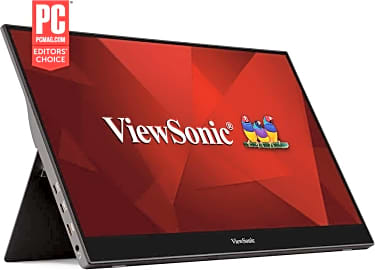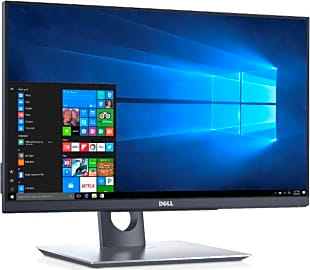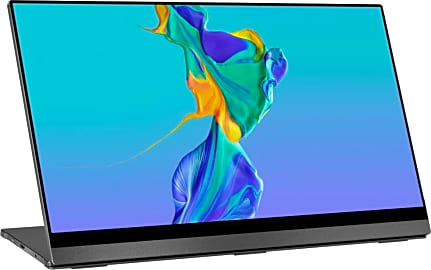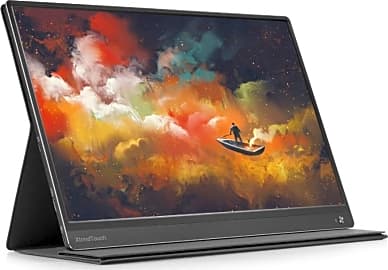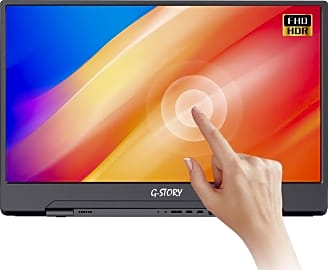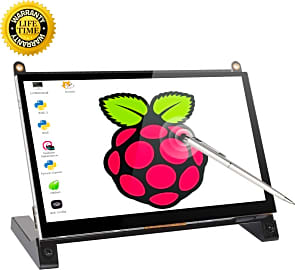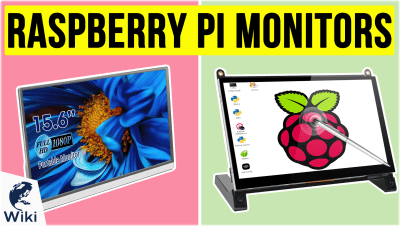The 10 Best Touch Screen Monitors

This wiki has been updated 41 times since it was first published in February of 2015. Ideal for adding a separate display to your workstation or streaming video from your smartphone, these touchscreen monitors deliver impressive picture quality in a variety of sizes. They're available with a range of capabilities designed for everything from casual use to specialized applications, and some even offer advanced features like wide color gamuts and simulated HDR processing. When users buy our independently chosen editorial selections, we may earn commissions to help fund the Wiki.
Editor's Notes
December 01, 2020:
You'll notice some well-known brands near the top of our list. The ViewSonic TD2455 and Dell P2418HT, for example, come from highly respected manufacturers and both feature two hinges that allow for premium ergonomics. The Asus VT229H isn't quite as versatile, but it's still a very high-quality desktop display. Rounding out the selection of popular brands is the ViewSonic TD1655, which does a considerably better job as a portable display than a wide swath of the options from lesser-known companies.
That said, though, there are some really great models on the market right now that you may not have heard of. The UPerfect Smart is probably the best example of one, as it is the only readily available pressure-sensitive model that we could find, and even boasts an ultra-wide color gamut. The combination of these two premium features makes it a great choice for artists and editors who want to create on the go. The UPerfect Portable isn't geared toward those same creatives, but it has a similarly impressive panel and is among the few with an Ultra HD resolution.
Speaking of portable monitors, the G-Story GSV56FT is a moderately priced choice that should serve casual users well, while the XtendTouch XT1610F is one of the few with an internal battery that's actually worth mentioning.
Then we have a couple more specialized options that are worth considering for the right projects. As the name implies, the Angel POS 17-Inch is an ideal choice for point-of-sale operations, while the Eviciv MDS-702 could work well for a wide range of applications, although not really high-definition entertainment, due its somewhat odd stand and limited resolution.
December 06, 2019:
There are a few different kinds of touch monitors and they all serve different purposes. Among those most similar to standard desktop displays, the Asus VT229H is one of the newest, and its smaller sibling is just as good and measures 16 inches rather than 22. The Dell P2418HT is no slouch, either, with the kind of image quality that you'd expect from such a popular manufacturer. And the Acer T272HUL is one of the most noteworthy because not only does it measure an impressive 27 inches, it also sports a 1440p resolution, which is currently just about the best in the class. The Planar PCT2235 is reasonably priced and comes in a few sizes with a highly convenient dual-hinge stand or an optional Helium one. For that matter, if you like a fold-flat stand, check out the ViewSonic TD2760, which is pretty expensive but also looks fantastic -- it just doesn't work with Apple products.
Then there are the compact, portable options, such as the Asus ZenScreen MB16AMT, which has an impressive amount of integrate technology. It takes advantage of the newest Type-C connector technology and looks surprisingly good for something so thin and light. The Gechic 1303I looks nearly as sharp, although it's not as large, and the G-Story 15.6-Inch is an excellent value even if its image quality leaves a bit to be desired.
There are also a couple specialty items worth pointing out. The Angel Capacitive POS can serve you well in business settings, and if you need more like it, we'd suggest checking out Dell's website (listed in our Special Honors section) for their Elo line of touch displays. The Eviciv MDS-702 is also a somewhat specialized device, as while it does work with Windows, it's a bit small for general usage, but it's a perfect primary display for the Raspberry Pi.
Special Honors
Dell Monitors There are two types of Dell displays with touch capability. Their Elo series is designed for use as a touch-enabled kiosk, while their Interactive line is a group of massive displays (think big-screen TV sizes) with projected infrared multi-touch support. The first group is relatively inexpensive and compact; the second will set you back thousands of dollars but is almost the only such boardroom-ready solution. dell.com
Samsung Interactive Ranging from 13 to 75 inches diagonally, Samsung's touch line offers a wide range of functionality. Among their more interesting offerings are the Flip and Flip 2 families, which are essentially high-tech digital whiteboards, and also available in portrait-oriented versions. If your firm does a lot of live collaboration, they're worth a look. samsung.com
NEC V554-T NEC has long been a fixture in the corporate A/V and electronics world, and their latest group of large-format touch screens proves they're right where they belong. They don't have many to choose from, and most are limited to FHD resolutions, but they are capable of true 10-bit color and have relatively responsive 10-point touch support using IR projection. necdisplay.com
What is a Touch Screen Monitor?
Multi-touch features allow the user to swipe, tap, zoom and pinch using only their hand.
A touch screen monitor can be prompted by physical contact; either with a finger or stylus device. In short, the human hand replaces the keyboard and mouse functions. The touch component can be manipulated as well. Multi-touch features allow the user to swipe, tap, zoom and pinch using only their hand.
You probably interact with more touch screen monitors then you realize on a daily basis. They can be found just about everywhere: video game consoles, smart phones, kiosks, and ATMs are prime examples.
How do they work? In short, it's complicated. But to simplify things, let's break down touch screens into the two most obvious types.
Resistive touchscreen is the simple and basic touch screen model. The screen is composed of two layers of glass. The layers face each other and they are separated by a thin gap of air. A stylus or finger presses the outer layer down forcing contact with the inner layer. This creates a connection point and produces voltage, which is read on the processing board. That connection point is now simply a high-tech button.
Resistive touch screens are used in high volume environments like restaurants and airports due to their durability, water resistance, and low cost. Also they are employed in the video gaming industry. Nintendo uses this type of screen most notably with the handheld Nintendo DS.
Capacitive sensing is more complex. The screen is composed of glass coated with a thin transparent layer of Indium Tin Oxide which acts as a conductor. Since the human body is a conductor of electricity as well, the contact creates a distortion in the electromagnetic field that is read as a change in the screen. While this touchscreen is much more precise, it is fragile, (as noted by half of all smartphone cracked screens) and usually requires skin to screen contact.
Why Should I Get a Touch Screen?
The benefits of touch screens are discernible. They are more intuitive. There is no need for you to memorize keyboard shortcuts. Since you're physically interacting directly with the screen it cuts computing time considerably. Physically swiping something away is more instinctual than burying your head down and hammering away on a keyboard for the same effect.
Some experience a tough learning curve; clumsy, small buttons, can't use gloves, etc.
You cannot deny the precision of using a stylus; particularly for drawing and art. It's a requirement for animation and graphic design students to be proficient with touch screens.
Also, there is no need for additional equipment and they eliminate set up time. There is no need for a hard surface to rest a mouse or trackpad on.
The downside of touch screens cannot be diminished with a wave of the hand. Some experience a tough learning curve; clumsy, small buttons, can't use gloves, etc. The natural oils from hands are also a deterrent; unavoidable, but can be battled with a screen protector. Most will say this is a small bump in the road and just requires more screen wipes with a cloth.
Gorilla arm is a condition experienced from excessive use of arm and hand movements with a monitor, resulting in fatigue. Most will never experience this, and touch screens are typically not as strenuous to support this phenomenon.
Touch screens tend to be more expensive as a whole over their non-touch counterparts, while portable models also have a shorter battery life because their touch layer requires more energy.
The History of Touch Screen Monitors and a Look to the Future
Touch screens go further back than you may imagine. They were first mentioned in 1965 and invented by E.A. Johnson. By 1968, published articles mentioned the benefits of touch screen technology in the air traffic control industry. CERN was next to manufacture a working model in 1973 and by 1982, resistive touchscreen was invented.
They were first mentioned in 1965 and invented by E.A. Johnson.
The growth of touch screen technology flourished in the 1980's until today due to the need from many other industries to incorporate the new invention: medical, video gaming, and automotive industries were all pioneers of touch screen technology.
The next logical question is if touch screen technology will completely replace non-touch screens. Most will say no. The danger of gorilla arm, hand oils damaging the surface, and higher cost will deter a large minority of consumers. However, developments are being made daily in the industry. In the near future we will see touch screen technology using other parts of the hand; knuckles and fingernails to control other functions.



